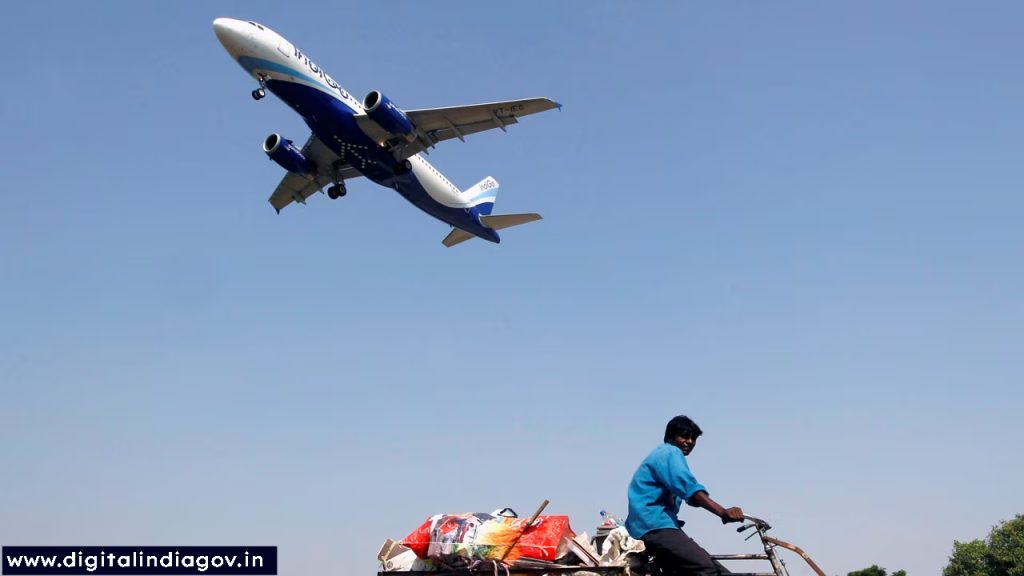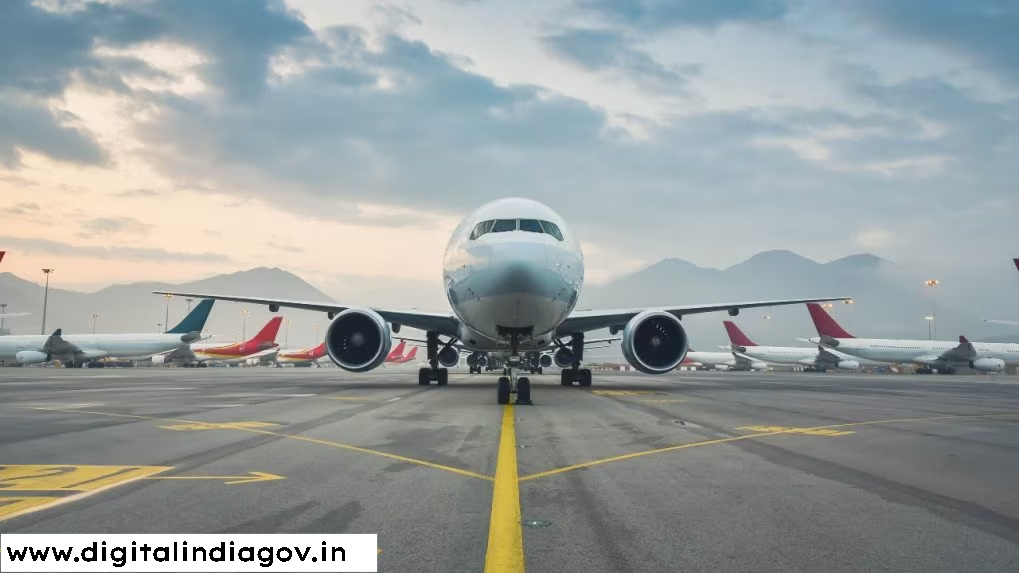UDAN Scheme:- “Ude Desh Ka Aam Nagrik” is the complete abbreviation for UDAN. This program links rural regions across the nation with big cities through inexpensive regional aircraft. There are now 78 more routes available for low-cost carriers according to UDAAN 4.0. The Regional Connectivity Programme covers lines that are 200–800 km long. Exceptions to this lower restriction include hilly, remote, island, and security-sensitive areas. To ensure balanced regional growth, a maximum of 25% will go towards each of the North, West, South, East, and North East areas.
Contents
What is the UDAN Scheme?
UDAN, also known as Ude Desh Ka Aam Nagrik, is an initiative that aims to reduce air travel expenses for the general public residing in tier II and tier III Indian towns. Value Added Tax (VAT) and service tax at one-tenth of the rate will be subject to a 2% excise charge by the central government. Airports participating in the regional connection system would also be able to freely share codes. A levy levied on some flights would be used to fund the scheme; the proceeds would be deposited into a Regional Connectivity Fund (RCF). According to the government, if the passenger load factor stays high, the three-year phase-out of Viability Gap Funding (VGF) will occur after the route reaches self-sustainable.

Also Read:- Agneepath Scheme Apply
Objectives of the UDAN Scheme
- The main objective of the Ude Desh Ka Aam Nagrik Scheme is to increase the accessibility and affordability of air travel.
- The National Civil Aviation Policy (NCAP) includes the Scheme.
- Both the Indian government and the state governments support it.
- Through UDAN, travel to remote cities is also incredibly inexpensive.
Provisions of the UDAN Scheme
- Benefitted Airports: By rehabilitating current airstrips and airports, the UDAN initiative seeks to link underserved and unserved airports.
- Implementing Agency: The Airports Authority of India (AAI) is in charge of carrying out the project.
- Phases of the Bidding: By the end of 2018, there will be three separate phases to the route award bidding process.
- Applicable Route Length: There is no lower limit for hilly, rural, island, or security-sensitive locations for routes that fall within the 200–800 km range covered by the scheme.
- The program would be financed by a tax imposed on specific flights, which will be transferred to a Regional Connectivity Fund (RCF).
- Flight Cost: A flight that travels at a speed of about 500 km/h will set you back Rs. 2,500. Helicopter operations, priced at Rs. It will now be possible for the first time to pay 2,500 for a 30-minute journey.
- Allotments, up to a maximum of 25%, shall be split equally among the five areas (North, West, South, East, and North East) in order to guarantee equitable regional development.
- Incentives: The program encourages airlines to start more flights to smaller, underserved towns and cities, thereby boosting the viability of these businesses.
- AAI Amount Invested: By 2019–20, the AAI intends to upgrade airport infrastructure at a cost of Rs. 17,500 crore.
- UDAN ‘Seats and Departures’: A minimum of 5 and a maximum of 13 seats will be available on each helicopter journey.
Benefits And Features Of UDAN Scheme
- In essence, the Indian government’s UDAN Scheme is a program for the development of regional airports.
- In essence, it is a component of a regional connectivity plan to improve the underutilized flight paths.
- This plan will enable widespread and inexpensive air travel.
- This initiative will connect rural communities to larger cities and make air travel more affordable and accessible.
- The program’s inaugural flight occurred in 2017.
- Approximately 60 lakh individuals have taken flights for a mere Rs 2,500.
- This scheme will connect one thousand air service routes.
- One crore passengers will travel each year when the plan is implemented.

Also Read:- CG Bhuiya, Digitize India, Digitize India Platform, Work From Home Jobs
Salient features of the UDAN Scheme
The program has a ten-year lifespan. Competing bids are used to choose the airlines that participate in UDAN.
The Central government offers the following support
- reimbursement for Value Gap Funding (VGF) for airlines taking part in the program.
- Tickets bought through the program are subject to a reduced GST rate.
- Opportunities for codesharing on flights covered by the policy.
State Governments extend the following measures
- decrease of the GST to 1% for ten years.
- cooperation with oil firms to enable facilities for refueling.
- land set aside for airports and related developments.
- skilled guards on duty.
- subsidized rates for utilities.
- 20 percent of VGF.
Airport operators, such as AAI, provide the following concessions
- At participating airports, there are no fees for parking, landing, or storage.
- The terminal navigation landing charges (TNLC) are zero.
- The airline chosen through the bidding process will handle ground handling.
- The Airports Authority of India discounted RNCF (Route Navigation and Facilitation Charges) to 42.4% of standard rates.
Various Phases of the UDAN Scheme
- UDAN 1.0: Under this phase, five carriers assigned 128 flight routes to 60 airports, 36 of which were newly established.
- UDAN 2.0: The Ministry of Civil Aviation selected 73 unserved and underserved airports in 2018. The second phase of the UDAN proposal included the first-ever connection of helipads.
- UDAN 3.0: Working with the Ministry of Tourism, UDAN 3 incorporates tourism routes. Seaplanes will connect water aerodromes. adding several routes in the Northeast to the UDAN network.
- UDAN 4.0: The fourth phase of the Regional Connection Scheme (RCS), known as Ude Desh Ka Aam Nagrik (UDAN), approved 78 new routes in 2020 with the goal of bringing connection to rural and regional areas of the country.
- UDAN 4.1: The main goals of UDAN 4.1 are to link smaller airports and to provide particular connectivity for seaplanes and helicopters. In partnership with possible airline operators, the Ministry of Ports, Shipping, and Waterways is overseeing the ambitious project known as Sagarmala Seaplane Services.
- UDAN 5.1: Using helicopters, the government started UDAN 5.1 to increase connectivity in rural India.
Achievements of the UDAN Scheme
As per information made public by the Ministry of Civil Aviation in August 2022:
- Through the remarkable improvement of air connectivity to Tier-2 and Tier-3 cities, the UDAN initiative has revolutionized travel by providing low airfares.
- There are now 141 airports in service, up from 74 in 2014.
- The UDAN program has connected 68 underserved/unserved areas, comprising 58 airports, 8 heliports, and 2 water aerodromes.
- UDAN has made it easier to connect by flight to over 29 states and union territories with 425 new routes.
- Roughly one crore passengers have benefited from this scheme.
The Significance of UDAN
- Passengers can travel to and from rural airports like Hissar in Haryana, Burnpur in West Bengal, Darbhanga in Bihar, Hubballi and Baldota in Karnataka, and others through the Ude Desh Ka Aam Nagrik (UDAN) Scheme.
- India’s aviation industry benefits from the UDAN plan, which gives new and small operators the opportunity to contribute to the swift growth of passenger traffic.
- The program opens up regional routes, and airlines must compete for the sole right to fly on such routes.
- As the country’s new aviation map includes rural areas, strong regional links should also help those areas’ businesses.
- In addition to addressing the problem of phantom airports, the idea lowers travel expenses.
- The program provides Viability Gap Funding to make these operations financially viable, which incentivizes airlines to introduce new routes to underserved smaller cities and towns.

Also Read:- Pudhumai Penn Scheme
Challenges of the UDAN Scheme
- Many smaller regional airlines’ precarious financial situations have made the plan more difficult to implement.
- Despite having received UDAN approval, there is little indication that the routes are practical or even partially operational.
- Many players just have one or two planes, which should be practiced more frequently. These lesser players need to have access to new planes.
- The main reason for UDAN’s failure is that it is a market-driven program, meaning the government must increase the routes’ profitability for airline companies.
- Bids under UDAN are filed based on the airline operator’s demand assessment for that specific route or route.
FAQ’s
Q. For what does UDAN stand?
Ans– The airline operator’s demand assessment for the particular route or routes in question informs the bids submitted under UDAN.
Ans- The Udan is a regional airport development project with the dual goals of lowering air travel costs and enhancing connectivity to rural and regional areas of the nation.
Q. The UDAN scheme was started by whom?
Ans- On April 27, 2017, Indian Prime Minister Narendra Modi kicked off the first regional aircraft between Delhi and Shimla, initiating the program.
Q. Who is responsible for implementing the UDAN program?
Ans- AAI, or the Airports Authority of India, has been selected as the Scheme’s Implementing Agency.
Suggested Link:- Our Jharkhand
@PAY
